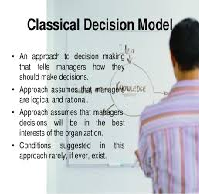The Classical and Behavioral Models of Decision Making Review the classical and behavioral models of decision making the information presented below then write an essay of approximately 400 words PROVIDING EXAMPLES OF WHEN YOU HAVE USED OPTIMIZING DECISION MAKING AS WELL AS EXAMPLES OF WHEN YOU HAVE USED SATISFICING DECISION MAKING FOR YOUR REAL LIFE SITUATIONS.

It these decisions can be as simple or intricate as you’d like as long as they are coherent with these two models.
Here is some background information on these models for reference:
The Classical and Behavioral Models of Decision Making
Classical decision theory views the manager as acting in a world of complete certainty. Behavioral decision theory accepts the notion of bounded rationality and suggests that people act only in terms of what they perceive about a given situation.
Classical and Behavioral Decision Theory: Classical decision theory assumes that the manager faces a clearly defined problem, knows all possible action alternatives and their consequences, and then chooses the alternative that offers the best, or “optimum,” solution to the problem.
The Classical and Behavioral Models of Decision Making
Most of us have access to decision-making support from expert systems that reason like human experts and follow “either–or” rules to make deductions. Fuzzy logic that reasons beyond either-or choices and neural networks that reason inductively by simulating the brain’s parallel processing capabilities are becoming operational realities that will move beyond simple programmed decisions.
Bounded rationality is a shorthand term suggesting that, while individuals are reasoned and logical, humans have their limits. Individuals interpret and make sense of things within the context of their personal situations. They engage in decision making “within the box” of a simplified view of a more complex reality. This ultimately leads to satisfying wherein decision makers choose the first alternative that appears to give an acceptable or satisfactory solution to the problem.
The Classical and Behavioral Models of Decision Making
This makes it difficult to realize the ideal of classical decision making. As a result, the classical model does not give a full and accurate description of how most decisions are made in organizations.
The Garbage Can Model: The garbage can model views the main components of the choice process – problems, solutions, participants, and choice situations – as all mixed up together in the “garbage can” of the organization. When the organizational setting is stable and the technology is well known and fixed, traditions, strategy, and the administrative structure help order the contents of the “garbage can.” When the organizational setting is dynamic, the technology is changing, demands are conflicting, or the goals are unclear, the components of the “garbage can” get mixed up.
The garbage can model highlights two important organizational facts of life:
-Different individuals may do choice making and implementation.
-Many problems go unsolved.




